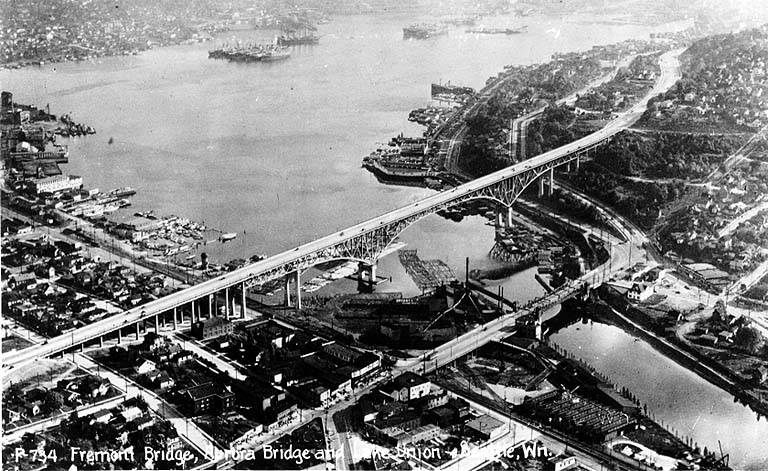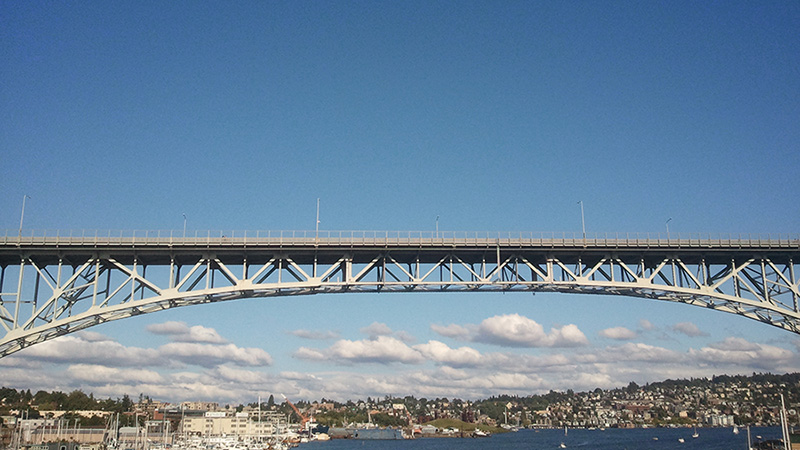What is now Aurora Avenue N began in 1888 as Aurora Street in Denny & Hoyt’s Addition to the City of Seattle, Washington Territory, previously discussed in our post on Dravus Street. Edward Blewett and his wife, Carrie, of Fremont, Nebraska, were the landowners, and Edward Corliss Kilbourne (1856–1959) filed the plat as attorney-in-fact for the Blewetts. Dr. Kilbourne (a dentist), was from Aurora, Illinois, and it seems to be generally accepted (The Fremocentrist, Wedgwood in Seattle History, Fremont Neighborhood Council, Pig-Tail Days in Old Seattle) that he named the street after his hometown.
(I have seen elsewhere [HistoryLink, Washington’s Pacific Highway], that Aurora was given its name sometime in the early 20th century by George F. Cotterill, mayor of Seattle from 1912–1914, because it was “the highway to the north, toward the aurora borealis,” but they have the century wrong, and Aurora Street was no highway in 1888. In addition, those two pages call him “city engineer, later mayor,” but he was never city engineer — although he was assistant city engineer from 1892–1900. The Licton Springs Community Council mentions both theories.)
At any rate, Ordinance 6947, filed on June 6, 1901, refers to the street as Aurora Street, and Ordinance 7942, filed on November 5 of that year, refers to it as Aurora Avenue. I can find no specific record of the name change, but Ordinance 6864, filed on May 8, has to do with “altering, defining and establishing the names of streets in the City of Seattle in the portion thereof lying north of Lake Union, Salmon Bay and the route of the Lake Washington Canal,” and is likely responsible. (No text is available online for the ordinance, and the drafters of Ordinance 6947 must have neglected to take the change into account.)
Aurora Avenue N might have remained just another North Seattle street were it not for the decision to route the Pacific Highway, U.S. Route 99, across the Lake Washington Ship Canal there instead of Stone Way N, Albion Place N, Whitman Avenue N, or Linden Avenue N. As it happened, Aurora was chosen as the location for the crossing (known today as the Aurora Bridge), and the name was officially extended through Queen Anne to Downtown Seattle in 1930 in preparation for the bridge’s opening in 1932.
Added July 14, 2023: I spoke to Feliks Banel of KIRO Newsradio for one of his All Over the Map segments, this one on how the Aurora Bridge got its name. I didn’t appear on air, but was mentioned in both the audio and web versions of the story.


Today, Aurora Avenue N begins at 7th Avenue N and Harrison Street by the north portal of the State Route 99 Tunnel and goes 7⅘ miles north to the city limits; the name continues 3 further miles to the King–Snohomish county line, and the highway another 12 miles beyond that to Broadway in Everett. A block-long segment from 6th Avenue and Battery Street to Denny Way has been renamed Borealis Avenue, and Aurora between Denny Way and Harrison Street is once again 7th Avenue N. A two-block-long segment underneath the north approach to the Aurora Bridge has also been changed to Troll Avenue N.
Born and raised in Seattle, Benjamin Donguk Lukoff had his interest in local history kindled at the age of six, when his father bought him settler granddaughter Sophie Frye Bass’s Pig-Tail Days in Old Seattle at the gift shop of the Museum of History and Industry. He studied English, Russian, and linguistics at the University of Washington, and went on to earn his master’s in English linguistics from University College London. His book of rephotography, Seattle Then and Now, was published in 2010. An updated version came out in 2015.
